Deus Ex: Invisible War Preview
Ion Storm's sequel to Deus Ex promises revolutionary gameplay and graphics. We check out an early version of the PC game.
It's hard to point to a first-person game that's given you more options to find your own way through story-driven action missions than Deus Ex, released for the PC back in 2000 and for the PS2 early last year. Often called a role-playing game because of its extensive dialogue and sophisticated system for developing and customizing your character, J.C. Denton, Deus Ex also had equal parts first-person combat and stealth. What it didn't have were cutting-edge graphics. Ion Storm got much more technically ambitious for the upcoming sequel, which will have dynamic lighting reminiscent of Doom III and a full physics system. But what makes Deus Ex: Invisible War so astonishing is that the technical enhancements will feed right into the gameplay. We simply can't wait to see if Ion Storm pulls it all off by the time the PC and Xbox versions are due out later this year.
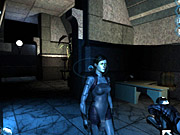
At a recent visit to Ion Storm's office in Austin, Texas, we had a chance to see a pre-alpha version of the game and early versions of the opening cinematic that sets up the story. Deus Ex: Invisible War takes place in the mid-21st century, some 15 years after the first game, and nanotechnology is much more widespread. One of the first game's signature features was its multiple endings, which let you confront different parts of a global conspiracy. Naturally the designers have had to pick one ending to be the basis for the next game's story, but they just won't say which one.
The cinematic opens as a high-rise in Chicago is being evacuated. A terrorist has been spotted in the city, and attack drones are launched as the figure approaches the building. It's too late--the terrorist has time to open a cylinder and unleash a nano explosion that seems to feed off the material around it. But key members of the research team inside the building are able to escape by helicopter and leave for a more hidden installation in Seattle. An ominous voice echoes the title and gives a clue as to how it fits into the story: "We don't need armies. We have the cells in human bodies--an invisible weapon in an invisible war."
In the first Seattle mission, you'll find out that your character, Alex D., is one of four nano-enhanced agents working for the shadowy organization attacked in the city-leveling catastrophe. In the new game, you can choose to play as either a male or female character, both named Alex, and there are a few other options to customize the superficial looks of the two player models. Ion Storm invested a fair amount of effort to double all the voice work for the main character, and it's directly in response to requests from fans of the first games. The first mission is intended as a gradual introduction, and only at the end of it do you have to decide how to customize Alex's abilities.
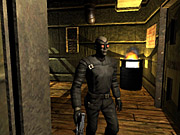
Just as J.C. Denton accumulated superhuman skills and nano special abilities as you progressed through the first game, Alex will make similar progress. But now the system of skills and nano augmentation has been unified: There are nine bio-mod slots that can each be upgraded three levels. In the first mission, you'll get three bio-mods, and that's where the tough choices start. You can assign one to three different slots to get a variety of abilities or upgrade one to its maximum level, which will generally provide a radical enhancement--for example, an eye bio-mod will provide night vision at the first level, but it can be upgraded to allow you to see enemies through walls at the higher levels.
Dynamic Possibilities
To make for even more customization, there are three different paths to go down for each bio-mod slot--a binary choice between two standard abilities or a third option of getting black-market bio-mods. The black-market technology--imported by a Russian group, the Omar--often has a dark side, like the health leech, which heals you by breaking down the organic material in nearby dead bodies. The bot domination mod may be too good to pass up--it lets you take control of a bot, anything from the simple cleaner bots to powerful military bots depending on the mod's level, to do surveillance or use its special abilities. However, in the meantime, your body is completely vulnerable, so you'll need to hide it somewhere out of the way.

Ion Storm is taking pains to make it possible to play all the way through Deus Ex: Invisible War without touching a weapon, but of course there's also a big arsenal of powerful weapons for those who prefer havoc over subtlety. While you can specialize in heavy weapons, even pistols can be quite powerful, and there are upgrades that can be found for each weapon type. One of the best ways to get through secure windows without setting off an alarm is with a pistol upgrade that silently disintegrates the glass. There are also a bunch of gadgets, including binoculars with a laser mic that you can use to listen in on faraway conversations, a noisemaker item useful for distracting enemies, and the multitools that can be used to pick locks and disarm security measures.
Some of your abilities can have offensive side effects, like the strength augmentation, which lets you pick up heavier objects and even toss crates across a room to gib unarmored enemies. It's also possible to use the environment to your advantage. Some locations will have barrels lying around that give off a poisonous gas when hit with a bullet, and more leaks appear with more damage. In a demo of the Antarctic level, we watched Alex take out a sentry on a distant catwalk by springing a leak in a canister near his patrol route. Smarter enemies won't fall for such a simple trap--and bots are naturally not affected--but if you have the environmental bio-mod that makes you immune to the gas you might set off enough canisters to fill a room, then retreat there to lure in chasing guards.
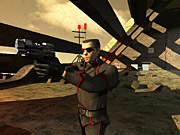
Ion Storm doesn't script sequences but instead tries to set up missions that create many different dynamic possibilities, which means that there are many different ways to overcome or avoid challenges that often match up to the bio-mods you've picked. Ion Storm's studio director, Warren Specter, noted that instead of scripting an impressive sequence where an enemy dramatically breaks through a glass window to surprise you, he'd rather set it up so the monster AI reacts and breaks through if you carelessly run down the corridor but don't detect a sneaky player. At the very least, the sequence wouldn't play the same way every time. Deus Ex was a long game, made even longer by the possibility of saving and reloading to try out different outcomes. We can expect Invisible War to have many of the same qualities, but it will be a somewhat shorter game, likely around 20 hours long albeit with quite a bit of replay value.
Back to the Future
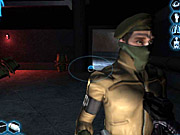
There are plans to have many more story forks in Invisible War, and the conspiracy is an even more tangled web that will have you balancing your allegiance between four rival factions: the World Trade Organization, the Order, the Templars, and J.C. Denton's own organization. All the factions' missions take place in the same locations, but different characters will be available to talk to, and the levels may be set up somewhat differently, with doors locked or unlocked. The game has a massive amount of dialogue, and playing all the way through a given story path will expose you to only a fraction of it. There are even two different helicopter pilots that will take you from location to location--one who is always available but drops you off in less desirable spots and another you must rescue and actively take care of but who can put you down in better locations.
At E3 2002, Ion Storm showed off some of the impressive technology behind the new game, notably the dynamic lighting. The studio licensed the Unreal engine and Havok's physics system but decided to rewrite the graphics engine to support Doom III-like lighting and normal maps, which are textures that create shadows on the characters and environments as if they were made up of many more polygons. With the normal maps, if you look at one of the 3000-poly characters in full bright light, you might not see many wrinkles in its clothes or the relief of its ears, but under low, directional lighting conditions there will be appropriate shadows that highlight such details. As we've seen before, the physics and lighting work together to create some cool effects, like being able to shoot lights on chains to make them move and cast dynamic shadows. Every light in the game is dynamic, which does push up the game's hardware requirements quite a bit. But producer Harvey Smith said that it's worth it because it takes the gameplay to another level. And while Doom III is the only other game announced for 2003 with such a lighting system, it should be the norm a couple of years down the road.
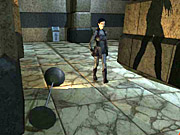
Invisible War will have nighttime and otherwise universally dark locations as in the first game. One of the levels we saw, which was set in a school for the gifted in Cairo, featured a series of naturally lit rooms and outdoor plazas. While the dynamic shadows are a lot less obvious in such a situation, the location was particularly stylish, and it was a slower-paced mission, so we didn't have to worry about sneaking around in shadows. In one room was a holographic jukebox that could be activated to play a tune sung by the game's female rock star. This is just one example of the holographic style of the new computer terminals, and when you're conversing with another character at a terminal you'll see a lip-synched portrait. We got a look at a few of the returning characters that will make an appearance, notably J.C. Denton, Paul Denton, and Tracer Tong, and they're all sporting a new look. Tracer Tong's facial scars are now normal-mapped and are appropriately disfiguring in strong shadows, while the Denton brothers have been redrawn to shed their long leather trench coats and look less Matrix-like.
Devil's in the Details
There's also plenty of action to be had in dark, seedy locations, like the mercenary bar in lower Seattle. We saw plenty of odd characters in the bar, including Tracer Tong, a serious-looking Omar agent, and quite a few bystanders checking out a cockfight between mutant greazels. It was here that we saw a demo of the game's rag-doll physics, which makes every death animation unique and uses appropriately constrained joints so that, say, elbows don't twist in odd directions. Shooting characters standing at the top of the bleachers made them fall and tumble realistically, and one even fell between the slats in the benches. Specter doesn't want his games to have gratuitous gore, but he thinks that the rag-doll effects reinforce the consequences of killing.
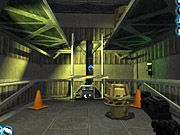
Ion Storm hit a major development milestone just before our visit. All the game components and levels have been assembled in a build that can be played from start to finish, although Specter admitted that no one had run through it yet. Each of the levels is built up in layers, and the levels we saw were said to be among the most complete, about three-fifths of the way to their polished state. The game's interface just went through a complete overhaul that will replace the conventional look seen in all the current screenshots. The new interface better suits the premise and looks like a display imprinted on the character's retina--status displays and selectable bio-mods are arranged in a blue transparent circle at the periphery of the screen.
The PC and Xbox versions of the game are in simultaneous development, and in fact, both use exactly the same files. Specter says he doesn't think complexity and depth of gameplay are the same thing, and while Ion Storm learned something about console controls from making the PS2 version of Deus Ex, the minor streamlining of the new game's interface doesn't mean it's been at all dumbed down. It's clear that the PC version of the game will have aggressive hardware requirements, at least a GeForce3 or Radeon 8500 graphics card. But since it's likely to come out around the same time as Doom III, it's quite possible that many gamers who don't already have high-performance systems will upgrade for one game or the other. There will definitely be support for 5.1 audio, and Ion Storm has some additional plans for the game's audio that it couldn't talk about yet.

Deus Ex: Invisible War has incredible potential, but clearly there are some technical hurdles for Ion Storm to overcome before its release. The most obvious is the frame rate, which was running at no more than 20 frames per second on either the PC or the Xbox, and sometimes much less. The goal is to get the frame rate to a constant 30 frames per second. The enemy AI itself is another challenge, given how many different situations it's expected to react to, including dynamic light conditions. And certainly, it's always a big task to test and balance a game that gives players so many options. In 2000, Ion Storm shipped the original game with polished gameplay but with some technical issues, and we'll just have to hope there's enough time to iron everything out for the release of Invisible War. Specter said he couldn't specify an exact release date other than "2003," but he noted that a date would be set soon. Look for more on the game in the coming weeks.
Got a news tip or want to contact us directly? Email news@gamespot.com
Join the conversation